Alnwick Castle: From Norman Fortress to Renaissance Retreat
by Teri Foster Gray
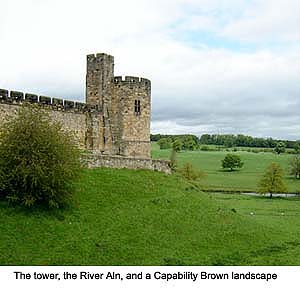 Built just twenty years after the Norman Conquest, Alnwick Castle
tops a hill overlooking the peaceful pastoral landscape designed
by Capability Brown. That peace was hard-won, as Alnwick was
built as a border fortress and remained so from its founding
until the unification of England and Scotland that came with
accession of James I. Even then, conflict continued. Escaping
Lancastrians took refuge in the Postern Tower and escaped across
the Aln (pronounced "Allen") via the small door now used by the
current Duke to take his dogs for their morning romp. The
devoutly Catholic Thomas Percy, younger brother of the 6th earl,
took up the cause of Mary Queen of Scots, as did his son and
namesake, the 7th earl. Both died for it. The 8th and 9th earls
fared little better. Both were imprisoned. Time, and a staggering
£30,000 fine paid by the 9th earl, healed all, and the 10th
earl was chosen as guardian for the orphaned children of Charles
II.
Built just twenty years after the Norman Conquest, Alnwick Castle
tops a hill overlooking the peaceful pastoral landscape designed
by Capability Brown. That peace was hard-won, as Alnwick was
built as a border fortress and remained so from its founding
until the unification of England and Scotland that came with
accession of James I. Even then, conflict continued. Escaping
Lancastrians took refuge in the Postern Tower and escaped across
the Aln (pronounced "Allen") via the small door now used by the
current Duke to take his dogs for their morning romp. The
devoutly Catholic Thomas Percy, younger brother of the 6th earl,
took up the cause of Mary Queen of Scots, as did his son and
namesake, the 7th earl. Both died for it. The 8th and 9th earls
fared little better. Both were imprisoned. Time, and a staggering
£30,000 fine paid by the 9th earl, healed all, and the 10th
earl was chosen as guardian for the orphaned children of Charles
II.
The Percy family's record of service to England is
second to none. The first English Percy came to England with
William the Conqueror and died on the First Crusade. Four
generations on, Richard de Percy was named one of the 25 barons
charged with overseeing the provisions of the Magna Carta. The
list continues through Harry Hotspur, a battle veteran at age
eight, knighted for valor at age 11, and subject of Shakespeare's
play Henry IV, and George 9th Duke, who died in World War
II. Percys have served as generals and Lord High Admiral,
governess to Queen Victoria, (Charlotte Florentia, wife of the
Third Duke) and on the Medical Research Council. Along the way,
they have found the time to amass a collection of paintings by
Gainsborough, Canalletto, Titian and other masters, the vast
quantities of porcelain on display in the dining room, the
Aubusson tapestries that line the chapel, and a two-story library
full of rare books, while improving the castle (the first Duchess
had the curtain wall torn down and the River Aln move 100 feet
east so she could enjoy the view), benefiting the local
community, and excavating artifacts from sites as distant as
Egypt and Pompeii and as nearby as their own moat.
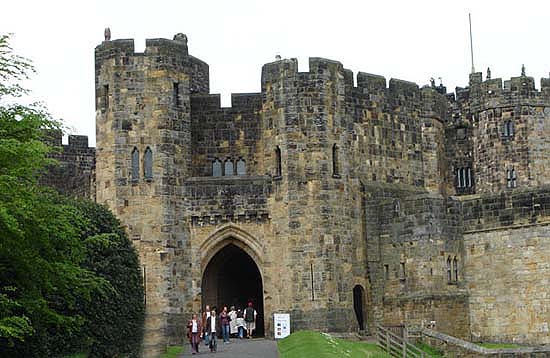
Algernon, 4th Duke, a patron of the lifeboat movement, set up
a coastal weather station in the library with information
reported daily to help insure the safety of local fishermen. When
he decided to refurbish the castle in the style of the Italian
Renaissance, rather than import Italian craftsmen, he brought
Anton Leon Bulletti to Alnwick to supervise the work and
established a school of woodcarving to train local workers to
produce the ornately carved doors, shutters and ceiling panels.
The castle reflects all this. You can tour the formal dining
room, drawing room, and library, where along with objects of
historic and artistic importance, one sees subtle reminders that
this is a private residence: the flat screen TV tucked in an
alcove in the library, a Simpsons chess set in the drawing room,
thirty feet from one of the ebony cabinets made for Louis XIV.
(Yes, Homer is king and Madge is queen.)
Tours of the grounds begin every 40 minutes starting at 10:30 AM.
The last starts at 3:40. Be sure to explore on your own, as
well--two museums are within the castle grounds. The Antiquities
Museum in the Postern Tower, opened to the public in 1826, is
devoted to archaeology and holds specimens ranging from mosaics
from Pompeii to fragments of prehistoric Northumbrian Rock Art
and Hadrian's Wall. While more extensive collections of Roman
artifacts are displayed at other museums, the Duke's Museum gives
the best overview of the archaeology of Hadrian's Wall. Each of
the excavated Roman forts has a display devoted to the
individuals who studied and cataloged it, but here you will find
the threads tied into a more complete narrative.
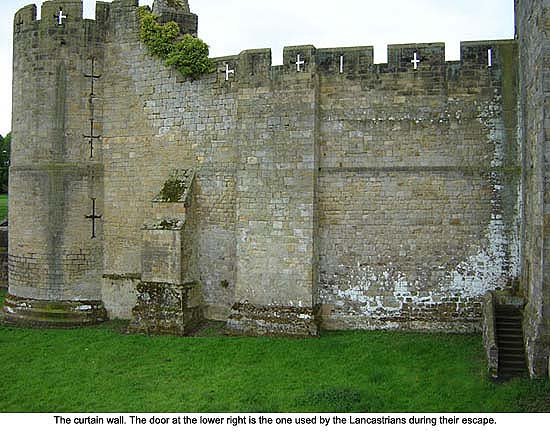
As you tour the castle, various parts will seem oddly
familiar. An enterprising lot, the Percys have been known to rent
the castle and its grounds to filmmakers, and various bits have
served as backdrop in Robin Hood Prince of Thieves, Elizabeth,
Harry Potter, and any number of BBC historical epics.
The Fusiliers of Northumberland Museum is in the Abbot's Tower.
In addition, the Constable's Tower exhibits equipment belonging
to the Percy Tenantry Volunteers, who served during the
Napoleonic Wars; the dungeon in the 14th century South Tower
holds a moaning waxworks prisoner; and there is a small display
of antique transportation devices ranging from the ducal coach to
bicycles, sedan chairs, and a wheelchair near the café.
If you have children, be sure to take them to The Knight's
School, where they can dress in medieval garb and participate in
activities designed to teach them about the realities of medieval
life. (Parental supervision required.)
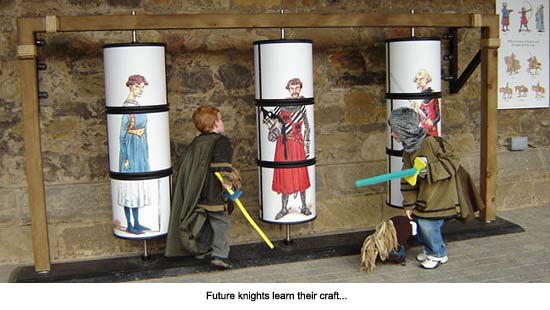
10 (or More) Things to Do Around Alnwick
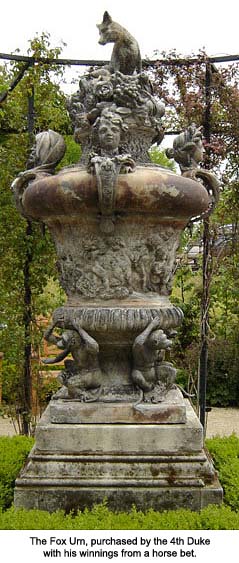 The time to
visit Alnwick (and please pronounce it "Annik") begins on the
last Sunday in June, when the week-long Alnwick Fair kicks off.
The Fair, costumed procession, roast ox sandwiches and all, is
heaven on earth for Medieval re-enactors. Bring your chain mail
and surcoat, by all means, but please leave your sword at home. The time to
visit Alnwick (and please pronounce it "Annik") begins on the
last Sunday in June, when the week-long Alnwick Fair kicks off.
The Fair, costumed procession, roast ox sandwiches and all, is
heaven on earth for Medieval re-enactors. Bring your chain mail
and surcoat, by all means, but please leave your sword at home.
While in Alnwick, visit the restored Alnwick Garden, the
Duchess's project, which has been wildly successful since its
opening in 2003, and the Bailiffgate Museum, in the former St.
Mary's Church, which specializes in the history of the Border
Country. (You will get a 20% discount on your admission if you
show your Alnwick Garden brochure.)
Beyond Alnwick - To the South:
From Alnwick, south on B6341 to Rothbury.
At Rothbury, ten miles southwest of Alnwick, you can visit
Cragside, the Victorian mansion of William, Lord Armstrong, an
immensely successful engineer, arms manufacturer, and inventor.
This house, designed by Richard Norman Shaw, was completed in
1884, and is the first house in the world to have been lit by
hydroelectric power.
From Rothbury, south on B6341, then right on A696 to Otterburn.
Otterburn, the site of Henry Hotspur's defeat of James, Earl of
Douglas in 1388, is marked by a stone cross about a mile north of
Otterburn village, on A-696.
From Otterburn, take B6320 south, approximately 10 miles to Bellingham.
In Bellingham, ("Bellingjum" to the locals) visit the medieval
Church of St. Cuthbert, designed with a stone roof to fire-proof
it against border reivers, and the Heritage Center, which focuses
on the Reiver period. From Bellingham, any number of hiking and
biking trails, including the Penine Way and National Cycle Route
No. 68, lead to outdoor activities and spots of historical
interest.
From the Bellingham Heritage Center, go west. Drive carefully, as
you will share the road with Regional Cycling Route No.10 for
most of your route. The Kielder Castle Information Center is
approximately 16 miles.
Kielder Water is man-made, and of relatively recent origin, but
just north stands Kielder Castle, the 1775 hunting lodge of the
Dukes of Northumberland, now open to the public and housing a
Visitors Center and a bike rental. Along the way from Bellingham,
stop in at the Pheasant Inn, which dates from the early 17th
century.
From Kielder, you can go north approximately two miles to the
ominously-named village of Deadwater at the Scottish border or
retrace your steps to Bellingham, then follow B6320 south to
Chesters Roman Fort to begin exploring Hadrian's Wall. (See story
on Hadrian's Wall.)
To the North:
From Alnwick, take B1340 north. At Littlehoughton, follow the
sign to Craster. (B1340 turns left. You will go straight.) Bus
service is available from Alnwick.
Dunstanbergh Castle, a brisk walk from the fishing village of
Craster, displays the ruins of a 14th century castle.
From Craster, take the coastal route north. The road will
rejoin B1340 in approximately 2 miles.
Seven miles north of Dunstanburgh, Bamburgh Castle dominates the
coast, a brooding pile atop a formidable basalt cliff. First
fortified by the Celts, then the Saxons, it served as the capital
of Anglo-Saxon Northumberland. Abandoned, fallen into ruin, it
was purchased by Lord Armstrong (he of Cragside fame) in 1894 and
transformed into a turn-of the-century imagining of a genuine
castle. It now functions as a museum which houses Lord
Armstrong's collection of Faberge eggs, a painting by Jan Brughel
the Younger and, in the basement of the Keep, a collection of
suits of armor and other military antiques.
Continue north on B1340 to B1342, right on A1. Follow the signs to Lindisfarne.
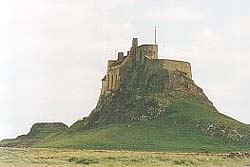 Continuing up the coast, about eight miles north of Bamburgh, one
finds the Holy Island, or Lindisfarne, reachable only at low
tide. (Tide tables are available at all Northumberland tourist
offices.) Founded by St. Aidan in 634, the monastery became a
center for evangelism, scholarship, and art. The renowned
illuminated Lindisfarne Gospels, now on display at the British
Museum, were created by the monks there.
Continuing up the coast, about eight miles north of Bamburgh, one
finds the Holy Island, or Lindisfarne, reachable only at low
tide. (Tide tables are available at all Northumberland tourist
offices.) Founded by St. Aidan in 634, the monastery became a
center for evangelism, scholarship, and art. The renowned
illuminated Lindisfarne Gospels, now on display at the British
Museum, were created by the monks there.
The monks deserted the island in 875, retreating before the
Vikings, and the structure stood abandoned until the Benedictines
reclaimed it in 1082. It never regained its former eminence,
however, and was vacated again during the Dissolution. What is
left of the priory is from the Benedictine period, with a few
incised stones on display in the museum the only remnant of the
original monastery. While there, do visit Lindisfarne Castle, a
moldering ruin when Edward Hudson, the founder of Country Life
magazine, purchased it at the turn of the century. His deep
pockets, and the talents of architect Edward Lutyens, transformed
the place into a Edwardian holiday home, which honors the spirit
of the original 16th century structure.
Continue north on A1 to A1167 to Berwick-upon Tweed.
Military history buffs will want to visit Berwick-on-Tweed at the
Scottish border to see the effect of the invention of artillery
on fortification design. The city ramparts, built by order of
Elizabeth I, who feared a Franco-Scot alliance and invasion, are
not tall, but immensely broad and still in pristine condition. In
addition to the Ramparts, Berwick is home to the Barracks Museum,
the Guardhouse, and the ruins of Berwick Castle.
More Information:
We regret that we no longer have the resources to maintain up-to-date links and/or hours and pricing details for the various sites and attractions listed on this website. For more information about the location(s) listed above, please use your favorite search engine or visit Wikipedia.
Teri Foster Gray lives in the Pacific Northwest with her husband and Labrador Retriever. A mild-mannered banker by day, she writes novels and travels whenever possible. Her journeys have included two years in Hawaii, six months in Europe, and the British visit that resulted in this piece. She has recently completed a novel, The Shadow Empire.
Article and photos © 2006 Teri Foster Gray
Lindisfarne Castle photo courtesy of Wikipedia.org
|
